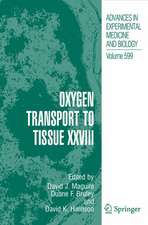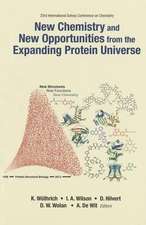Lactate: Physiologic, Methodologic and Pathologic Approach
Editat de P. R. Moret, J. Weber, J. -C. Haissly, H DENOLINen Limba Engleză Paperback – 31 mar 1980
Preț: 716.84 lei
Preț vechi: 754.56 lei
-5% Nou
Puncte Express: 1075
Preț estimativ în valută:
137.19€ • 142.69$ • 113.25£
137.19€ • 142.69$ • 113.25£
Carte tipărită la comandă
Livrare economică 12-26 aprilie
Preluare comenzi: 021 569.72.76
Specificații
ISBN-13: 9783540098294
ISBN-10: 3540098291
Pagini: 276
Ilustrații: XII, 260 p. 5 illus.
Dimensiuni: 170 x 244 x 14 mm
Greutate: 0.45 kg
Editura: Springer Berlin, Heidelberg
Colecția Springer
Locul publicării:Berlin, Heidelberg, Germany
ISBN-10: 3540098291
Pagini: 276
Ilustrații: XII, 260 p. 5 illus.
Dimensiuni: 170 x 244 x 14 mm
Greutate: 0.45 kg
Editura: Springer Berlin, Heidelberg
Colecția Springer
Locul publicării:Berlin, Heidelberg, Germany
Public țintă
ResearchDescriere
This book covers the principal reports and discussions which have been presented during the "Symposium on Anaerobic Metabolism and Lactic Acid" which was held in Anzere (Wallis, Switzerland) from 19th till 20th January 1978 under the patronage of the European Society of Cardiology. ~s Dr. Wilkie and Hermansen mentioned in their paper, Berzelius was the first one who recognized in 1807 "the existence of free lactic acid in the muscular fluid and thought that the amount of free lactic acid in a muscle is proportional to the extent to which it has been previously exercised". Since, many controversies have appeared, not as far as for its presence in the muscle, but as for its relations to oxygen debt or fatigue, to its physiological part, to its metabolism (oxydation or conversion to glycogen in situ), or to its pathological significance in clinical conditions. In this symposium, physiologists and biochemists tried to resolve some of the basic problems, they defined terminology and introduced new facts. Methods to determine the lactic acid or lactate have been reviewed. Lactic acid or lactate in various clinical conditions were the objectives of many collected reports in the last part of the symposium. Clinicians, who are interested in Pneumology, Diabetology, Hepatology, Angiology, Intensive Medicine or Sport Medicine, and particularly cardiologists will find precious information. The organizing committee thanks every reporter, specially the Chairmen, and everyone who took an active part in the preparation or realization of this symposium.
Cuprins
I Physiology.- Opening Remarks.- 1 Lactate Metabolism and Cardiac Muscle.- Discussion.- 2 Studies of Fatigue in Intact Anaerobic Living Muscle with Nuclear Magnetic Resonance (31p NMR): Present Results and Future Possibilities.- 3 Circulatory Responses to Exercise.- 4 Production of Lactic Acid in Heavy Exercise and Acid-Base Balance.- Discussion.- 5 The Quantitative Significance of the “Himwich-Cori Cycle” for Removal of Lactate During Recovery After Maximal Exercise in Man.- 6 “Oxygen Debt” Does Not Exist.- 7 Oxygen Debt: Its Role and Significance.- Discussion.- 8 Is the Use of Isotopic Tracers Valid for the Study of Lactate Metabolism in vivo?.- II Methodology.- Opening Remarks.- 9 Experience with an Enzymatic Monotest ® for the Determination of Lactate.- 10 Suitability of Yeast Lactate Dehydrogenases (Cytochrome b2) for Lactate Determination.- 11 Amperometric-Enzymatic Analysis of Lactic Acid.- Closing Remarks.- III Clinical Applications.- Opening Remarks.- 12 Lactic Acid and Other Metabolic Indicators of Anaerobiosis in Normal Subjects.- 13 Lactate and Pulmonary Pathology.- 14 Lactic Acid in Shock and Liver Failure.- 15 Peripheral Lactic Acid Production in Heart Disease.- 16 Blood Lactate Measurement in Peripheral Arterial Disease.- 17 Lactic Acid and Diabetes.- Discussion.- 18 Lactate and Pyruvate After Short Exposure to Altitude.- Closing Remarks.- Opening Remarks.- 19 Effects of Acidosis and Weak Acids on the Normal, Hypoxic, and Ischaemic Myocardium.- 20 Fundamental Validity and Clinical Usefulness of Myocardial Lactate Balance During Ischaemia. A Comparison with Other Biochemical Markers.- 21 Myocardial Release of Lactate, Inosine, and Hypoxanthine During Atrial Pacing- and Exercise-Induced Angina.- 22 Protection of the Ischaemic Myocardium.- Closing Remarks.- Conclusion.















